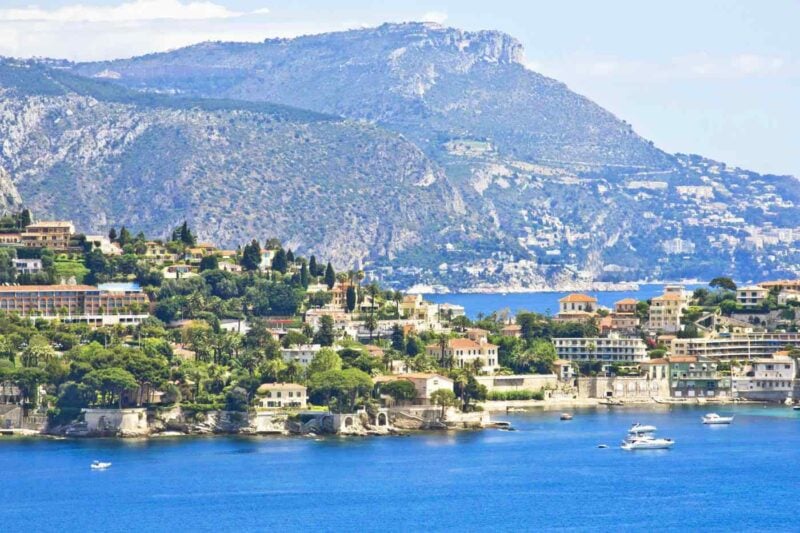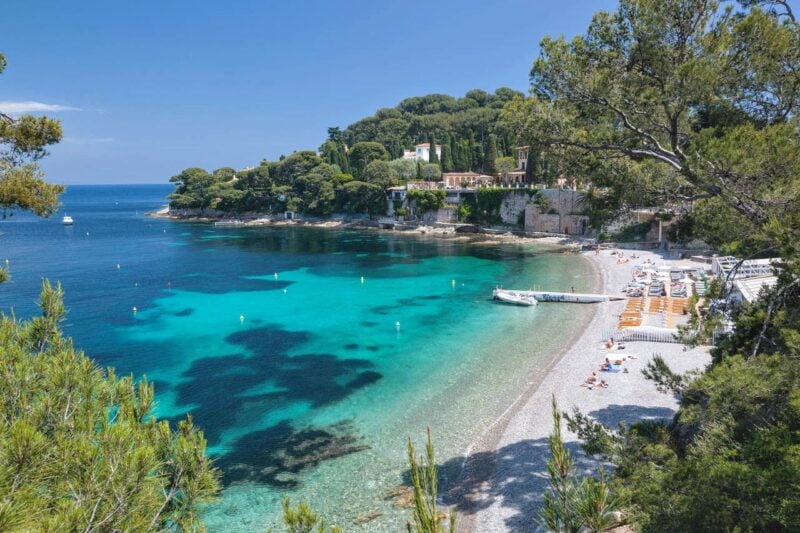Verknüpfungen
Reiseführer für Saint-Jean-Cap-Ferrat
Diese Halbinsel an der französischen Côte d'Azur ist legendär für ihre wilde Schönheit, atemberaubenden Villen und eleganten Yachten. Von seiner glamourösen Blütezeit bis heute ist Cap Ferrat ein Spielplatz für Hollywood-Stars, die sich dort mit echten Royals treffen – man kann fast die Champagnergläser der wohlhabenden Persönlichkeiten klirren hören, während man die mit Pflanzen gefüllten Innenhöfe und die weitläufigen Aussichten bewundert.
Halfway between Villefranche Und Beaulieu, it’s the most prestigious headland on the Riviera. From the Belle Epoque to the present day, it’s attracted people from all over the world who want to enjoy the good life. Its tranquility and warm climate make it a favorite holiday destination among both European aristocracy and international millionaires.

Saint-Jean-Cap-Ferrat is an exclusive community on the French Riviera that’s been known as a vacation hotspot for the well-heeled dating back to the late 1800s. Its abundance of opulent historic villas owned by millionaires and billionaires has earned the seaside Mediterranean village the nickname the “Peninsula of Billionaires.” Actors, politicians, royalty, and tech titans, from Winston Churchill to the late Microsoft co-founder Paul Allen, have vacationed or owned homes in the French seaside town. Locals—and they have included Henri Mattise, David Niven, Oscar Wilde, Charlie Chaplin, Noel Coward, Baroness Beatrice Ephrussi de Rothschild, the Rolling Stones, Paul Allen and Andrew Lloyd Webber to name just a few—call this one-time impoverished fishing village simply ‘Cap Ferrat’.
The peninsula is strewn with elegant houses, many of which have shocking scandals behind them, such as the delightful Villa Ephrussi de Rothschild , home to a remarkable collection of works of art. These luxurious villas are nestled among lush vegetation, discretely protected from prying eyes. They are some of the most expensive villas in the entire world, and are often include a private beach and locked gates. Otherwise masked by foliage, views of the shore can be admired from the coastal path, and from the path by St-Hospice Point . Today, this exclusive coastal community, known for its yacht-filled harbor and opulent historic villas, is home to only about 1,600 permanent residents.

Die Geschichte von St. Jean Cap Ferrat
Die Halbinsel Saint-Jean-Cap-Ferrat entwickelte sich gegen Ende des 19. Jahrhunderts zu einem führenden Ferienort. Die trockene und felsige Landschaft beherbergte ursprünglich nur eine Handvoll Fischer- und Bauernhütten, die rund um die Kirche und den Hafen gruppiert waren. Dieser Weiler war als Saint-Jean bekannt und gehörte zur Gemeinde Villefranche-sur-Mer.
Cap Ferrat ist ein Magnet für Adlige und High Roller, seit Leopold II. von Belgien die Villa Les Cèdres kaufte und erweiterte dort im Jahr 1830; Sein palastartiges Haus mit 14 Schlafzimmern war durch einen Tunnel mit dem Haus seiner Geliebten verbunden. (Hier ist die ganze verrückte Geschichte.) Das Anwesen Villa Les Cèdres ist der größte private botanische Garten der Welt. „Es ist ein wahrer Schatz, ich nenne es den Louvre der Botanik“, sagte Franklin Picard, der 1999 veröffentlichteein Kultbuch über Les Cèdres.

König Leopold II. ließ den größten Teil des hochgelegenen westlichen Teils des Kaps erschließen, der mit seinen Sonnenuntergängen und Ausblicken nach wie vor der exklusivste Abschnitt ist Nice und schön Villefranche-sur-Mer.
Cap Ferrat war so mild, dass zwischen Strandkiefern und Zypressen Bananenstauden und Palmen gedeihen konnten. Es war die Domäne von Piraten und Fischern (ähnlich wie St. Tropez). It was the convicts of Villefranche-sur-Mer prison that built the harbor, the hub of Cap Ferrat, between 1840 and 1876.
In 1876, the Compagnie Générale des Eaux created a 6800m³ artificial lake within leafy parkland. Fed by the river Vésubie, this lake also featured a small island and a waterfall. This water was the reason why the peninsula came to be covered in denser and more diverse vegetation. From then on, Cap Ferrat became a firm favorite with families who would arrive from Nice by horse-drawn carriage to have picnics under the pine and olive trees, or have lunch in one of the many restaurants that sprang up near the harbor.
As belle époque mansions burgeoned, so began a golden age that peaked during the Twenties when playwright Somerset Maugham bought a Moorish style house from Leopold’s chaplain. He hosted everyone who was anyone, from T S Eliot and the Duke and Duchess of Windsor to Winston Churchill.
At nearby Villa La Fiorentina – a vast property inspired by a Florentine palace with two swimming pools – Elizabeth Taylor and Richard Burton were photographed for the cover of Vogue, Frank Sinatra partied with Cary Grant, and there was an “escapade on a bicyclette” involving John F Kennedy and Grace Kelly.
A song composed in 1938 after a beach party by Noël Coward called I Went to a Marvellous Party sums up The Great Gatsby feel of this era: “Quite for no reason/ I’m here for the season/ And high as a kite/ Living in error/ With Maud at Cap Ferrat/ Which couldn’t be right… People’s behavior/ Away from Belgravia/ Would make you aghast.”
Read about the crazy stories behind some of Cap Ferrat’s most famous villas.

Unabhängigkeit
The County of Nice, which had belonged to the House of Savoy since 1388, was annexed to France in 1860. In 1904, Saint-Jean separated from Villefrance-sur-Mer and became an independent commune. Originally named Saint-Jean-sur-Mer, the commune took the name of Saint-Jean-Cap-Ferrat in 1907.
Tourismusentwicklung
In the early 1900s, winter tourism began to be popular on the French Riviera. Its very mild climate machte es für reiche britische oder russische Familien attraktiv, die es bald zu einem hochgelobten Reiseziel machten. Saint-Jean-Cap-Ferrat wurde sehr beliebt und die ersten großen Anwesen wurden gebaut.
In 1904, the Hôtel Bedford (now the Hôtel Royal-Riviera) was built at the base of the peninsula. Its geographical location made it popular with high society. Designed to accommodate wealthy cosmopolitan clientele, 1908 saw the construction of the Grand Hôtel (now owned by hotel chain Four Seasons) on the Cap-Ferrat headland surrounded by lush greenery.
Famous Visitors to Cap Ferrat
In the Fifties, tourism started to become more summer-based and Saint-Jean-Cap-Ferrat became a fashionable seaside resort popular with celebrities from all over the world. Visitors included Edith Piaf, Charlie Chaplin, Elizabeth Taylor and Richard Burton, Jean-Paul Belmondo, Roger Moore, Tony Curtis, David Niven and Romy Schneider, who got married there in 1966. It was also a haven for politicians such as Général de Gaulle, Valéry Giscard d’Estaing, Raymond Barre, Winston Churchill, George Bush, Bill Clinton and Boris Eltsine.
Henri Matisse paid many visits to the Villa Natacha, owned by the art publisher Alec Tériade. The painter had already created a stained glass window and a ceramic mural for the villa’s dining room. The publisher invited many of the artists he worked with to his villa, notably Chagall and Picasso, and even his fellow countryman Odysséas Elýtis, who won the Nobel Prize for Literature in 1979. Jean Cocteau painted murals in the Town Hall and throughout an entire villa. Charlotte Salomon, a Jewish artist of German origins, stayed at the Hôtel Belle Aurore (now the Hôtel La Villa Cap Ferrat) for two years, where she painted her masterpiece “Life? or Theatre?”.
Ever since, royalty, artists, politicians and rich industrialists have continued to fall in love with the unique charm of this place where the expression “In order to live happily, live hidden” becomes even more meaningful.
What to See in Saint-Jean-Cap-Ferrat
It’s a small area, but one of the most beautiful on the French Riviera. Here are the can’t-miss things to see and do in Satin-Jean-Cap-Ferrat:
See What Jean Cocteau Left Behind

The artist who had the biggest impact on Saint-Jean-Cap-Ferrat was Jean Cocteau. A regular guest at the ‘Santo Sospir’ villa whose walls he decorated with splendid but controversial frescoes, he was also behind the fresco that graces the wedding hall in the Town Hall , which can be viewed on request at the Town Hall reception.
Saint-Jean: A Tiny, Charming Town

The beach resort town of Saint-Jean liegt an der Ostseite der majestätischen, bewaldeten Halbinsel Cap Ferrat und ist einen Besuch wert. Mit einem Strand, einem Yachthafen, Geschäften und Restaurants ist es ein großartiger Ausgangspunkt, um Cap Ferrat zu entdecken. Es ist auch ruhiger und weniger touristisch als andere Orte an der Côte d'Azur. Das macht es ideal, wenn Sie den Souvenirläden gerne fernbleiben.
St Jean Cap Ferrat became a holiday haven in the early 20th century, with the arrival of wealthy foreign families, who built vast estates, like Villa Ephrussi de Rothschild. Once a fishing village, St-Jean is now a smart seaside resort, greatly sought after for its peacefulness. A few old houses overlook the harbor, now largely devoted to yachts. The stepped street south of boulevard de la Libération in the village also offers some fine viewpoints.
The Famously Stunning Cap Ferrat Walk

In order to better appreciate the beauty of Saint Jean Cap Ferrat, you can visit on foot by taking the coastal path. It is signposted for 14 km and divided into 3 parts: the tour of Cap Ferrat, the pine-forest and the Maurice Rouvier walk which links Saint Jean Cap Ferrat to Beaulieu.
Der Küstenspaziergang von Saint-Jean-Cap-Ferrat ist wohl der schönste Küstenspaziergang der Welt. Das üppige Grün, die weißen Felsen und das blaue Mittelmeer von Cap Ferrat machen diesen Spaziergang zu einem unvergesslichen Erlebnis. Der Küstenspaziergang kann in zwei kürzere Abschnitte unterteilt werden, oder Sie können die gesamte Wanderung auf einmal machen, was Sie um das gesamte Cap herumführt.
Here is a complete guide to the seaside Cap Ferrat walk.
The Elegant Villa Rothschild


If you love architecture, you’ll need to pay a visit to the Villa Ephrussi de Rothschild , which is open to visitors. They also hold many fantastic special events, which we will include in our Events Calendar.
The villa was built in 1905 to accommodate Beatrice Ephrussi de Rothschild’s ever-growing art collection. It became a hub for art of all kinds: literary parties, music, gatherings of art collectors, and riveting conversation. This was a space where culture-lovers could commune far from the hubbub of the French Riviera’s less modest areas.


Dieses Herrenhaus ist mit den Schätzen der Baronin Beatrice Ephrussi de Rothschild geschmückt. Mehr als 5000 Kunstwerke sowie eine beeindruckende Sammlung von Möbeln, Lampen und Teppichen sind ausgestellt.
Die Villa ist vor allem für ihre französischen, japanischen und tropischen Gärten sowie das Rosen- und Pflanzenfestival bekannt, das jedes Jahr im Mai stattfindet. Die Baronin ließ sich von ihren Reisen inspirieren und schuf sieben Gärten, die verschiedenen Themen gewidmet sind. Spanisch, florentinisch oder japanisch … der Garten der Musen, der Garten des Lapidariums, der Rosengarten … makellose Gehwege, Palmen und seltene Düfte umgeben dieses Paradies.
Open Hours: Open 365 days a year from 10am to 6pm except:
– In July and August from 10am to 7pm
– From November to January: Monday to Friday from 2pm to 6pm / weekends, public holidays and school holidays from 10am to 6pm. Last admission 1/2 hour before closing.
The bookstore-boutique is open during Villa hours.
The tea room is only open on weekends from November to January.
The restaurant is part of the visit to the villa. You must buy your entrance ticket from the hostesses.
Parking is available onsite.